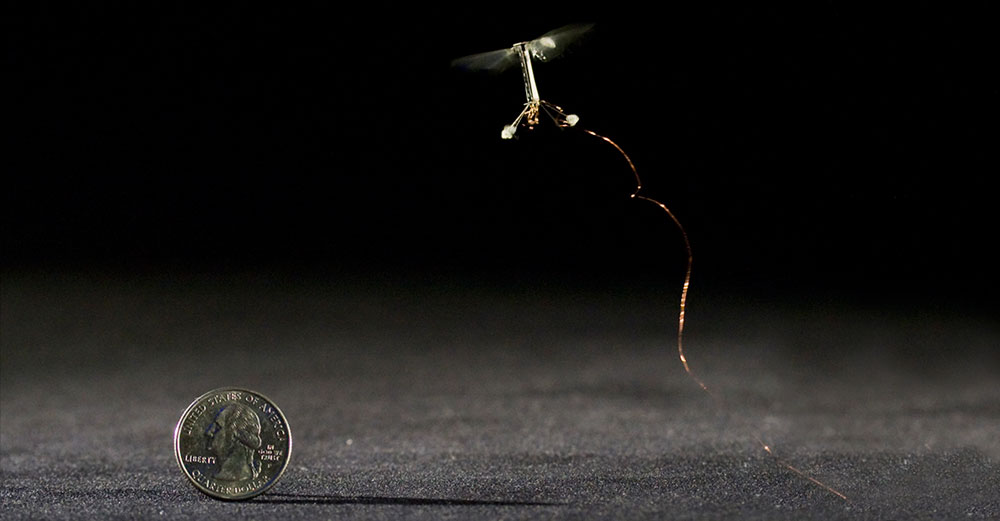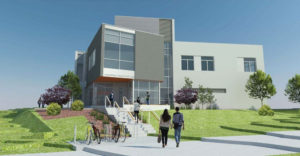
On the University at Buffalo‘s North Campus, Karthik Dantu is working on a set of robots so robust they’ll be able to navigate in crowded indoor environments and assist in offices, airports, and malls. Souma Chowdhury is writing algorithms to program swarms of small drones to map oil spills, survey forest fires, and locate survivors of natural disasters with minimal human intervention. Nils Napp is developing robots that can autonomously build scaled-up structures that use the same basic architectural principles as beaver dams and termite hills.
What do they have in common? “We work on different robotic platforms, but there are core robotic capabilities that are shared in everything we do, like mapping and sensing,” says Napp, assistant professor in the department of computer science and engineering. “We’re all focused on distributed robotic systems, rather than on the more traditional factory automation. We’re figuring out how robots can collaborate on a large scale, and as robots become more pervasive, our field grows increasingly important. Knowing where robots will be in five or ten years, we’re trying to anticipate what the problems will be and solve them ahead of time.”
Taking his inspiration from nature, Napp is exploring the potential of building with amorphous materials, including polyurethane foam, using his experiments to design learning algorithms for robots to construct complex structures on irregular terrain and fluctuating environments.
In a similar way, Chowdhury draws motivation from the flight patterns of birds in a flock, who fly without colliding with one another, and applies those lessons to flocks of drones that can safely travel over disaster sites, share information every five seconds, and quickly map an affected area before returning to base. “The foundation of the research in my lab is nature-inspired algorithms,” says Chowdhury, assistant professor of mechanical and aerospace engineering, noting that there are unique advantages to employing a team of drones that are inexpensive to buy, easy to transport, and cost only a couple of cents in electricity to power.
“It’s not as though the capacity of five drones is five times of their individual capacities,” Chowdhury explains. “When these drones interact in a smart way, leveraging swarm intelligence principles, their capacity grows exponentially. Our work is still at a preliminary stage, but we are starting to generate exciting evidence that drone swarms provide unique value in time-sensitive remote sensing or mapping, despite all the computing and communication challenges ubiquitous to such small and inexpensive robotic systems collaboration.”
To face those challenges, Chowdhury uses assembled drone platforms that need little additional equipment besides a mounted camera, a $35 computer, a small Lipo battery, and his lab’s software artifacts to accomplish some of the same goals as million-dollar satellites. For Dantu, who works on an even smaller scale, learning to fly swarms of RoboBees no bigger than a penny, the greatest difficulties come from adapting existing technologies to fit into a much smaller space.
“It’s a platform that’s very resource-constrained, so it pushes everything we do to the extreme,” says Dantu, assistant professor of computer science and engineering. “Having that very small platform provides great challenges in terms of computing and electronics. Motors don’t work well at this size, so you have to think of novel ways of getting the robots to operate, and the algorithms have to be rethought for scale. Typically, when we think of robot systems, we think of small numbers of robots, not tens or hundreds. That puts this work on the cutting edge, with a project that pushes all dimensions.”
In his most recent research, funded with a $1.1 million grant from the National Science Foundation, Dantu and his collaborators at Harvard University and the University of Florida are using micro-LIDAR (light detection and ranging) to develop the RoboBees’ sense of perception and navigation algorithms, which could ultimately be put to work pollinating crop fields or monitoring air pollution.
Chowdhury, who presented his research at the American Institute of Aeronautics and Astronautics’ Science and Technology Forum last winter, is preparing his drones to participate in a full-scale emergency field exercise on campus this summer; and Napp, who focuses on both hardware and software, is working with local architects and manufacturers on strategies for using robots to assemble temporary structures.
“As roboticists, we’re all focused on coordination and collaboration in multi-robot systems,” says Dantu. “We might approach our work from different directions, but we’re all combining theory and practice, looking at real-world challenges to provide practical solutions.”



